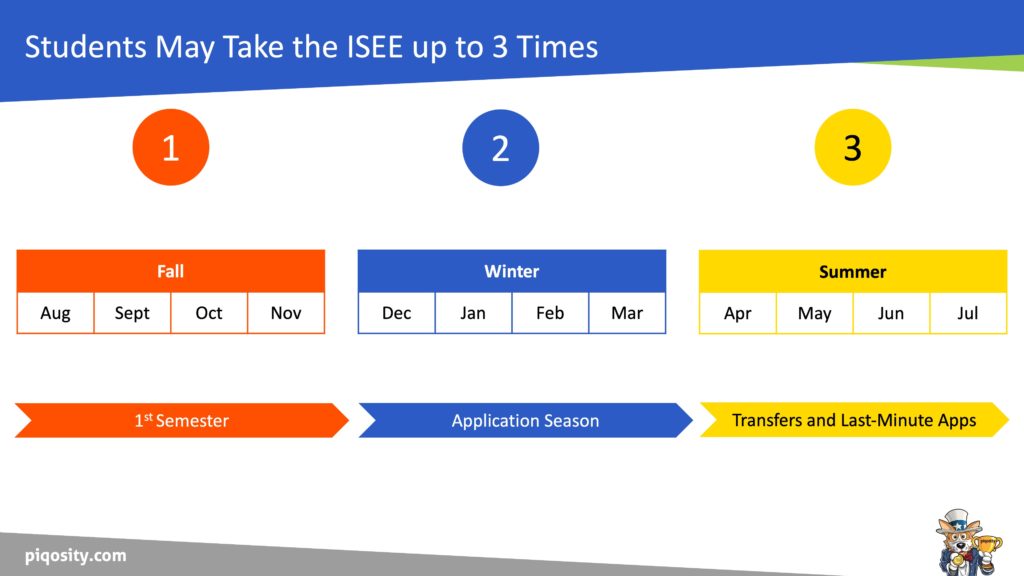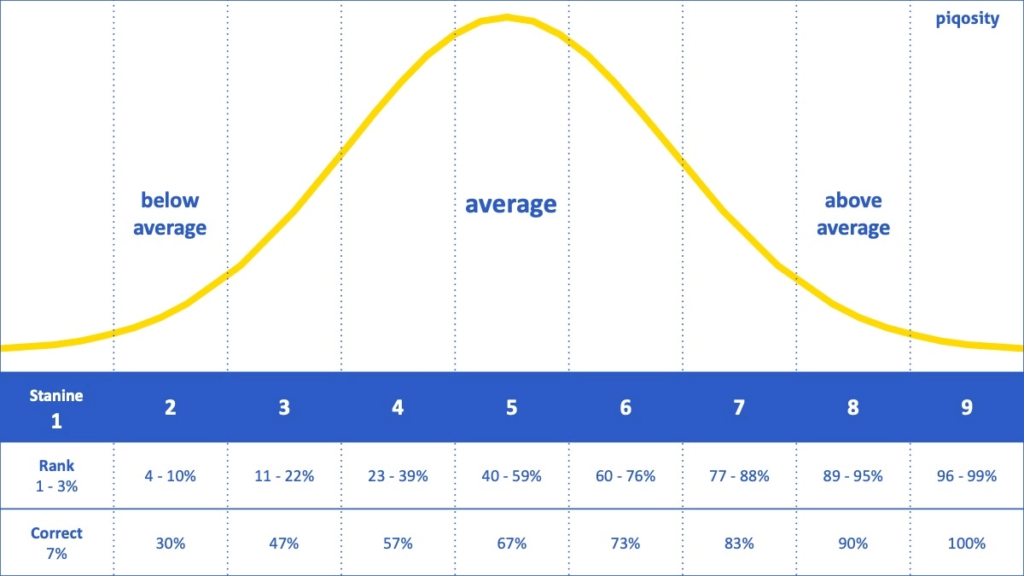
The use of the ISEE Middle Level as part of the admission process for prestigious private schools has recently grown in popularity. So if your child plans to apply to a school for 7th or 8th grade, then chances are that you’ve heard of the ISEE Middle Level test, but may or may not know exactly what it is and how to help your child or student prepare.
Piqosity is here to help. The market leader in ISEE test preparation, Piqosity has compiled everything you need to know about the ISEE Middle Level below.
Already have a grasp on ISEE basics? Get started preparing for the ISEE with our competitively priced ISEE Middle Level test prep today! Our courses include a free mini diagnostic test, adaptive practice questions, up to 10 ISEE Middle Level Practice tests, and more! For more information on this test and how Piqosity can help you succeed, check out our ISEE Upper and Middle Level prep guide.
What is the ISEE Middle Level Exam?
Before understanding what the ISEE Middle Level is, we need to answer the more basic question, “What is the ISEE?” The ISEE, which stands for Independent School Entrance Exam, is an admissions test intended for American students who are in the process of applying to private middle and high schools. It was developed by the Educational Records Bureau and in many respects is considered the “SAT and ACT of primary and secondary school admissions.”
The ISEE Test has four levels, each designed for students entering different grade levels.
- The Primary Level ISEE, for students applying for 2nd through 4th grades
- The Lower Level ISEE for those entering 5th and 6th grades
- The ISEE Middle Level, for students entering 7th and 8th grades
- The Upper Level ISEE, for students entering 9th to 12th grades
Because all schools use different curriculum, tests, and report card systems, ISEE test scores provide admissions boards with a more accurate benchmark by which to measure academic performance.
Many students opt to prepare in advance for the ISEE with practice tests and other test prep materials like those created by Piqosity in an effort to improve their ISEE score and help their application stand out from the crowd.
However, keep in mind that ISEE scores are not the be-all and end-all; schools consider ISEE scores alongside your child’s whole application!
What Makes the ISEE Middle Level Test Different Than Other ISEE Levels?
The ISEE Lower, Middle, and Upper Levels are all similar in terms of structure and duration. However, the content within each level of the ISEE is tailored directly to students entering certain grades. In other words, a student entering 5th or 6th grade would never take a Primary Level test, as this test is targeted to students entering 2nd through 5th grade and would be not challenging enough for effective placement.
ISEE Middle Level questions will mostly cover similar concepts to what your 5th or 6th grader should have already encountered (or will soon encounter) in school. Reading comprehension questions and the essay prompt are also based on concepts that are supposed to be interesting to that level’s intended age group, as test developers have determined that this helps the students’ performance.
What Can I Expect on the ISEE Middle Level?
Like both the Lower Level and the Upper Level ISEE, the ISEE Middle Level test includes four different sections and one essay. The first four sections contain 160 multiple choice questions. Each question offers four possible answers, with only one correct answer.
The test does not only test students’ knowledge, but also their logic. Some questions may cover concepts not yet covered by their current grade level. Students have two hours and forty minutes to complete the test, along with two breaks, making total ISEE testing time three hours.
1st Section: Verbal Reasoning
The Verbal Reasoning section of the ISEE Middle Level is designed to test students’ vocabulary skills and their ability to apply them. This section is broken up into two sub-sections; synonym questions and sentence completion questions.
Each section has forty questions, based on a grade-level appropriate, yet abstract, vocabulary word. The synonym section asks students to choose a word that has a similar meaning to the vocabulary in question. The difficulty here lies in knowing the four definitions of the four different answers, which are often based at a higher reading level.
Sentence completion questions omit a word from a sentence, prompting students to choose from a list of four possible answers. These questions are typically viewed as being a bit easier than the synonym questions.
Though this section is long, it actually has the shortest allotted time frame with only twenty minutes to complete it. This means the student has just thirty seconds to answer each question.
Study Piqoisty’s ISEE Middle Level vocabulary word list to prepare for these portions of the test!
2nd Section: Quantitative Reasoning
The Quantitative Reasoning section of the Middle Level ISEE focuses on a student’s mathematical logic. There are both quantitative comparison questions and word problems in this section, making thirty-seven questions total.
The questions require little to no actual calculation, rather, they make the test taker think logically about a math situation. Students have thirty-five minutes to complete these questions. Expect to face questions that involve numerical values, analyzing data, calculating probability, geometry, algebra, trigonometry, and more. You can review these concepts in our Math Review guide for the ISEE Middle Level and Upper Level.
Piqosity has observed that students have the most trouble with this section due to the higher level of abstract thought that it requires. Also, one of the four possible multiple choice answers is, “The relationship cannot be determined from the information given.” This answer can make some students anxious; many students struggle to decide whether this answer is the correct choice or if they simply have not yet learned the concept at hand.
Check out our tips for overcoming testing anxiety and math anxiety at Piqosity’s blog!
3rd Section: Reading Comprehension
The Reading Comprehension section of the Middle Level ISEE is designed to test the ability to understand the text. Thirty-six questions will be based on six different passages. Questions will consider:
- Main ideas
- Supporting ideas
- Vocabulary
- Logic
- Organization
- Inferences
- Style
- Tone
As we mentioned previously, the content is designed to be interesting and applicable to students in 6th and 7th grade. The passage may be fiction or nonfiction and will include keywords hidden in the text. The time frame for this section of the test clocks in at thirty-five total minutes.
Reading Comprehension tends to be the most competitive section of the Middle Level ISEE, as many students excel here. You can review types of reading comprehension questions with our ISEE reading comprehension guide.
4th Section: Mathematics Achievement
The Mathematics Achievement section of the ISEE Middle Level helps determine the test taker’s math skills, processes, and knowledge of mathematical terminology. Expect 47 questions here, which will require the student to make calculations and actually “do” math, through both word problems and various computations. Questions your child will face may include algebra, geometry, measurement, number operations, probability, and more. This section is forty minutes long.
You may wonder what the difference is between this section and the quantitative reasoning section. First, questions found in the Mathematics Achievement section involve actionable calculations and are more “straightforward” than those found in the Quantitative Reasoning section. Where mathematical achievement requires knowledge of how to use mathematical skills, quantitative reasoning asks about abstract and more hypothetical scenarios.
Note: There are absolutely no calculators allowed during any section of the ISEE test, so students will need to understand how to complete necessary calculations mentally or by hand.
5th Section: Essay
Finally, the Essay section of the ISEE Middle Level asks students to respond to an essay prompt. There are no right or wrong answers here, instead, students have the chance to show schools exactly who they are. Students have thirty minutes to make a personal reflection on a question/prompt, describe ideas, and organize their passage into a logical and well-written manner. This prompt will be age-appropriate, and something that the student will probably relate to.
The essay prompts are screened to be free of bias and relate to either the global community, the student’s community, or the students themselves. The prompts also rotate throughout the entire testing season, so even if the student takes the test again, they will not be tasked with writing the same essay twice.
Schools look to see how well students can express their thoughts through writing under pressure. They also consider how students perform without another party editing their work. They also want to see if students understand how their experiences affect and relate to them.
For your practice, we have compiled several examples of ISEE essay prompts.
How Do I Take the ISEE Middle Level Exam?
Students in the United States can take the ISEE up to three times throughout the year-long testing cycle. In other words, they can take the test once during each prescribed testing period.
These periods are:
- Summer: April – July
- Fall: August – November
- Winter: December – March
Thus, a student could not take the Middle Level ISEE in both September and October, but they could take the test in November and December. Most schools reviewing in-cycle applications will only accept scores from the two testing periods between August and March. For that reason, it’s wise to start thinking about taking the Middle Level ISEE just before the end of your child’s 5th grade year. In Houston, where Piqosity is based, the most popular times to take the ISEE are first in mid-November and second in early January.

The exact date when your child will take the ISEE will depend on what is offered by the local private schools in your area as there are no “national test dates” like there are with the ACT or SAT.
To sign up for the ISEE test, parents must register their children online. You can choose between a paper and pencil format or computer format for the test. You can also choose how you would like to receive the scores. Finally, anticipate a fee between $100 and $150, and additional charges depending on how you would like the scores delivered.
What To Expect on Test Day
The ISEE Middle Level tests are given at various private school locations throughout the United States. To keep students’ minds clear and on task, schools do not hold functions, promotions, or activities on a testing day.
Test proctors are teachers and school administrators who may already be familiar figures to your child. They will present test expectations and encourage students to ask for clarification if needed.
BRING:
- Four #2 pencils and two pens with blue or black ink, if taking the paper version of the ISEE test.
DO NOT BRING:
- Cell phones or other electronic devices
- Calculators
- Rulers
- Other mathematical instruments
- Dictionaries
- Thesauruses
Accommodations can be made on testing day for those with learning and physical disabilities or challenges. These conditions must be fully documented in order for accommodations to be put in place.
Understanding ISEE Middle Level Scores
Your child has taken the Middle Level ISEE, and their scores are on their way. But now you’re likely wondering what a good score actually looks like.
You and your child will receive a detailed score report, known as the Individual Score Report, about three to five days after the exam is taken. An email to your family will indicate that the scores are ready.
This report will show what questions were answered incorrectly, as well as the number of correct answers, and the test taker’s overall score. The score report will actually include three different types of scores: the Raw Score, Scaled Score, and Stanine Score. Of these, the Stanine Score, which is based on percentile ranking, is by far the most important to the admissions process. A Stanine Score of 7, 8, or 9, is best for an academically challenging school.

For an in-depth look at how to interpret all of these different ISEE score types, please reference our article, “What is a Good Score on the ISEE?”
The report will also include full explanations for each question so that your child can understand exactly what they need to change for a second attempt. Finally, the report will also indicate the test taker’s strengths and weaknesses, and help students understand where they may need to focus their efforts moving forward.
Above all, you and your child must understand that it is impossible to fail the ISEE or get a “bad” score. The schools you apply to dictate which scores they prefer, and your child’s test scores will reflect where they should be placed. You may want to chat with your preferred schools’ admissions counselors to understand exactly what kind of ISEE scores they tend to choose.
Strategies for Success on the ISEE Middle Level
When and how much a student should prepare for the ISEE depends on the academic competitiveness of the schools to which the student is applying and how well the student is already doing in school.
We recommend that students take either a real or practice ISEE by the summer before they plan to apply to a new school. The results of that “diagnostic test” will then guide them and their educators on how much preparation they will need in order to perform well on the ISEE.
To help your child prepare for testing day, make sure to review general areas of content that will be covered. Core academic competency is by far more important than testing tricks and tips.
For instance, make sure they review reading, writing, and math concepts. As stated previously, they should refresh their vocabulary knowledge. And finally, they should familiarize themselves with the test and question formats.
On testing day, students should:
- Read through questions thoroughly.
- Think of your own answer before reviewing the multiple choice options.
- Skip around to the easiest questions.
- Pass questions you do not know and return to them later.
- Keep track of how much time you have left, and don’t waste time.
- Do not leave questions blank, as this counts as a wrong answer.
- Even if you don’t know the correct answer, eliminate any potential answers you know are incorrect.
By practicing these strategies using practice tests your child will likely be better prepared when their actual testing day arrives.
Practice for the ISEE Middle Level Test With Piqoisty
The ISEE Middle Level test is essential when looking to enter a prestigious private school at grades 7 or 8. With Piqoisty’s full-length practice tests, you will be able to prepare adequately for your important test dates. You will get real feedback from our experts, as well as approximate Stanine scores.
Our LMS also allows teachers, tutors, and parents alike to encourage and support students as they make their way through test preparation. Group pricing is available!
Join for free and take our mini diagnostic tests to start your ISEE test preparation journey today!
More Educational Resources by Piqosity:
- Piqosity Now Offers Math Courses!
- FREE: 2021-22 ACT Writing Practice Test Sample Essays
- Why Your Child Doesn’t Need To Prepare for the ISEE Primary Level
- Strategies for Overcoming Math Anxiety
- Mississippi National Merit Finalists



Leave A Comment